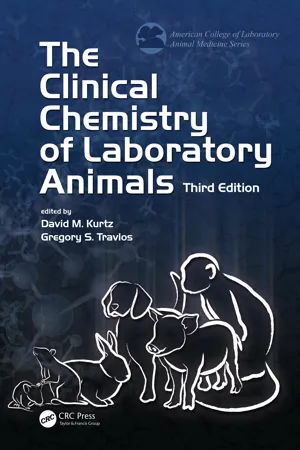
The Clinical Chemistry of Laboratory Animals
- 1,162 pages
- English
- ePUB (mobile friendly)
- Available on iOS & Android
The Clinical Chemistry of Laboratory Animals
About this book
Key features:
- Serves as the detailed, authoritative source of the clinical chemistry of the most commonly used laboratory animals
- Includes detailed chapters dedicated to descriptions of clinical chemistry-related topics specific to each laboratory species as well as organ/class-specific chapters
- Presents information regarding evaluation and interpretation of a variety of individual clinical chemistry end points
- Concludes with detailed chapters dedicated to descriptions of statistical analyses and biomarker development of clinical chemistry-related topics
- Provides extensive reference lists at the end of each chapter to facilitate further study
Extensively updated and expanded since the publication of Walter F. Loeb and Fred W. Quimby's second edition in 1999, the new The Clinical Chemistry of Laboratory Animals, Third Edition continues as the most comprehensive reference on in vivo animal studies. By organizing the book into species- and organ/class-specific chapters, this book provides information to enable a conceptual understanding of clinical chemistry across laboratory species as well as information on evaluation and interpretation of clinical chemistry data relevant to specific organ systems.
Now sponsored by the American College of Laboratory Animal Medicine (ACLAM), this well-respected resource includes chapters on multiple laboratory species and provides pertinent information on their unique physiological characteristics, methods for sample collection, and preanalytical sources of variation for the particular species. Basic methodology for common procedures for each species is also discussed.
New Chapters in the Third Edition Include:
-
- The Laboratory Zebrafish and Other Fishes
-
- Evaluation of Cardiovascular and Pulmonary Function and Injury
-
- Evaluation of Skeletal Muscle Function and Injury
-
- Evaluation of Bone Function and Injury
-
- Vitamins
-
- Development of Biomarkers
-
- Statistical Methods
The Clinical Chemistry of Laboratory Animals, Third Edition is intended as a reference for use by veterinary students, clinical veterinarians, verterinary toxicologists, veterinary clinical pathologists, and laboratory animal veterinarians to aid in study design, collection of samples, and interpretation of clinical chemistry data for laboratory species.
Frequently asked questions
- Essential is ideal for learners and professionals who enjoy exploring a wide range of subjects. Access the Essential Library with 800,000+ trusted titles and best-sellers across business, personal growth, and the humanities. Includes unlimited reading time and Standard Read Aloud voice.
- Complete: Perfect for advanced learners and researchers needing full, unrestricted access. Unlock 1.4M+ books across hundreds of subjects, including academic and specialized titles. The Complete Plan also includes advanced features like Premium Read Aloud and Research Assistant.
Please note we cannot support devices running on iOS 13 and Android 7 or earlier. Learn more about using the app.
Information
1 | The Laboratory Mouse |
CONTENTS
1.1INTRODUCTION
Table of contents
- Cover
- Half Title
- Title Page
- Copyright Page
- Dedication
- Contents
- List of Contributors
- List of Reviewers
- Chapter 1 The Laboratory Mouse
- Chapter 2 The Laboratory Rat
- Chapter 3 The Laboratory Rabbit
- Chapter 4 The Laboratory Dog
- Chapter 5 The Laboratory Pig
- Chapter 6 The Nonhuman Primate
- Chapter 7 The Laboratory Hamster
- Chapter 8 The Laboratory Guinea Pig
- Chapter 9 The Laboratory Ferret
- Chapter 10 The Laboratory Zebrafish and Other Fishes
- Chapter 11 Evaluation of Hepatic Function and Injury
- Chapter 12 Evaluation of Renal Function and Injury
- Chapter 13 Evaluation of Cardiovascular and Pulmonary Function and Injury
- Chapter 14 Evaluation of Skeletal Muscle Function and Injury
- Chapter 15 Evaluation of Bone Function and Injury
- Chapter 16 Biochemistry of Immunoglobulins
- Chapter 17 Complement
- Chapter 18 Transport Proteins
- Chapter 19 Acute Phase Proteins
- Chapter 20 Carbohydrate Metabolism
- Chapter 21 Lipids
- Chapter 22 Electrolytes, Blood Gases and Acid–Base Balance
- Chapter 23 Hormones
- Chapter 24 Vitamins, Selected Diet-Derived Factors, and Minerals
- Chapter 25 Development of Biomarkers
- Chapter 26 Statistical Methods
- Index